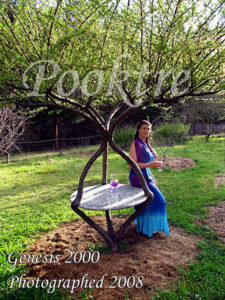 Part of the pooktre process of shaping trees is the decision of whether or not to use inclusions.
Part of the pooktre process of shaping trees is the decision of whether or not to use inclusions.
The are many steps to achieving a successful shaped tree project and deciding whether or not to use inclusions is an early step in the designing stage. Once we decide on using inclusion/s we need to figure out which material would be best to use with our design and how the tree’s growth and materials picked will work together for the greatest impact and effectiveness.
Below are a few snippets out of our book “Knowledge to Grow Shaped Trees”, from our Inclusions chapter.
 “Trees are amazing in the way they flow like honey. When they come upon an obstacle, they use a high vascular pressure to either push the object out of the way or to include it. The goal is getting the tree to incorporate the inclusion rather than push it away. The inclusion needs to be held in place for the tree until the tree grows strong enough to hold it with ease. With a heavy stone tabletop (60 kg), the tree will be strong enough to hold the stone long before it is ready for the supports to be removed. On a calm day there is no problem. On a windy day, however, the transfer of movement is a problem. Make sure the tree is well oversized before the supports are removed.”
“Trees are amazing in the way they flow like honey. When they come upon an obstacle, they use a high vascular pressure to either push the object out of the way or to include it. The goal is getting the tree to incorporate the inclusion rather than push it away. The inclusion needs to be held in place for the tree until the tree grows strong enough to hold it with ease. With a heavy stone tabletop (60 kg), the tree will be strong enough to hold the stone long before it is ready for the supports to be removed. On a calm day there is no problem. On a windy day, however, the transfer of movement is a problem. Make sure the tree is well oversized before the supports are removed.”
“Any materials that you are going to get the tree to hold must last at least as long as the anticipated life of the tree. Our inclusions consist of anything that is durable enough to withstand the weather, time and pressures imposed by the tree. Stone, metal, glass and ceramics are all good choices. Of course, some materials are better than others. When choosing materials for inclusions, there are different questions you should ask yourself,.
 Here are a few to get you started:
Here are a few to get you started:
1. Is this piece intended for harvest or to remain living?
2 How long will the material last in the weather?
3 What colour is the material?
4. Will the material get hot in the sun?
5. Will the tree continually shade the inclusion?
6. Will the material get stained from the tree dropping fruit/leaves?
7. How easy will it be to clean back a harvested piece with the inclusion in place?”
“It is always a good idea to seek professional advice about the type of material you are going to use and how it will be utilised. For example, glass that is to remain in the garden needs to have different properties than glass that will go into a table inside your house. Unless you have a good working knowledge of the material in question, use others’ expertise to help you decide. ”
Using inclusions expands the horizons of what can be created with shaped trees. From walkways through trees’ canopies, street signs, and city seating, to small 6-month projects like grown jewellery. It’s an amazing art form that can be very innovative.

